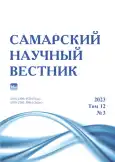Feeding conditions of the interspecific bumblebee association (Hymenoptera, Apidae, Bombus) in the central forest-steppe of the Omsk Region
- Authors: Krainov I.V.1, Sattarov V.N.1
-
Affiliations:
- Akmulla Bashkir State Pedagogical University
- Issue: Vol 12, No 3 (2023)
- Pages: 80-92
- Section: Biological Sciences
- URL: https://journals.rcsi.science/2309-4370/article/view/253140
- DOI: https://doi.org/10.55355/snv2023123111
- ID: 253140
Cite item
Full Text
Abstract
This article reports that the main food plants of bumblebees of the interspecific association of the central forest-steppe of the Omsk Region during the period of flight activity (I decade of May – III decade of September) are 120 plant species from 30 families. Common and fairly common species predominate, which, under the condition of medium, high and superfroductivity, form the forage base. All rare, quite rare, very rare, as well as unproductive common and unproductive fairly common plant species perform a supporting function in the nutrition of bumblebees. At the beginning of the flight activity of bumblebees, low and medium-productive species predominate, then after the beginning of flowering of new species, highly and super-productive ones are included in the feed spectrum – there is a change in food conditions from unfavorable to favorable. During the main flight period, bumblebees feed or forage on 99 plant species, among which fairly ordinary medium-productive species predominate. Before the second decade of August, three peaks in the expansion of the food spectrum were revealed: in the third decade of May (by 15 species), in the second decade of June (by 31 species) and in the second decade of July (by 20 species). The exclusion of plants from the bumblebee diet occurs every decade. The greatest peaks were recorded in the II decade of July and in the III decade of August – by 21 species. Starting from the first decade of September, there is a change in food conditions from favorable to unfavorable. In general, the feed base of bumblebees of the interspecific association of the central forest-steppe of the Omsk Region has a stable character and allows to provide bumblebees with a sufficient volume of full-fledged feed.
Full Text
##article.viewOnOriginalSite##About the authors
Ivan V. Krainov
Akmulla Bashkir State Pedagogical University
Author for correspondence.
Email: kivsib@mail.ru
applicant of Bioecology and Biological Education Department
Russian Federation, UfaVener N. Sattarov
Akmulla Bashkir State Pedagogical University
Email: wener5791@yandex.ru
doctor of biological sciences, chief researcher, professor of Bioecology and Biological Education Department, acting head of Ecology, Geography and Nature Management Department
Russian Federation, UfaReferences
- Гребенников В.С. Разведение и использование шмелей на красном клевере: метод. рекомендации. Новосибирск: Сиб. отд-ние ВАСХНИЛ, 1982. 52 с.
- Афиногенов А.З., Золотарева С.Н. Опыление растений шмелями в Западной Сибири // Биологические основы использования полезных насекомых / отв. ред. А.А. Захаров. М., 1988. С. 216–218.
- Лузянин С.Л. Трофические связи шмелей некоторых территорий Кузнецко-Салаирской горной области // Материалы XXXII апрельской конф. студентов и молодых ученых КемГУ. Т. 3, вып. 6. Кемерово: Полиграф, 2005. С. 343–344.
- Бывальцев А.М. Шмели (Apidae, Bombini) и комплекс посещаемых ими растений юга Западно-Сибирской равнины // Энтомологические исследования в Северной Азии: мат-лы VII межрегион. совещ. энтомологов Сибири и Дальнего Востока в рамках Сибирской зоологической конф. (Новосибирск, 20–24 сентября 2006 г.). Новосибирск, 2006. С. 214–216.
- Еремеева Н.И., Лузянин С.Л. Спектр кормовых растений шмелей юга Западной Сибири // Пчеловодство. 2007. № 7. С. 56–57.
- Конусова О.Л., Михайлова С.И., Прокопьев А.С., Акинина А.А., Литвинов А.А. Шмели (Hymenoptera, Apidae) – посетители недотроги желёзконосной Impatiens glandulifera Royle (Balsaminaceae) на территории г. Томска // Вестник Томского государственного университета. Биология. 2014. № 2 (26). С. 90–107.
- Демидова А.Т., Тюмасева З.И., Гуськова Е.В. Пищевая специализация шмелей (Hymenoptera: Apidae, Bombus Latreille) Среднеобской низменности // Ukrainian Journal of Ecology. 2018. Т. 8, № 2. С. 315–319. doi: 10.15421/2018_345.
- Атепалихин М.С., Кассал Б.Ю., Белим С.В. Использование ассоциативных правил для выявления взаимосвязи мест обитания биологических видов // Вестник Омского университета. 2014. № 2 (72). С. 125–129.
- Карташева Н.Н. Медоносные растения Томской области. Томск, 1955. 80 с.
- Садырин М.М. Пчеловодство в Омской области. Изд. 2-е, перераб. и доп. Омск: Омск. кн. изд-во, 1959. 165 с.
- Параева Л.К. Медоносные растения Западной Сибири. Новосибирск: Зап.-Сиб. кн. изд-во, 1970. 165 с.
- Глухов М.М. Медоносные растения. Изд. 7-е, перераб. и доп. М.: Колос, 1974. 304 с.
- Клименкова Е.Т., Кушнир Л.Г., Бачило А.И. Медоносы и медосбор. Минск: Урожай, 1981. 278 с.
- Пельменев В.К. Медоносные растения. М.: Россельхозиздат, 1985. 144 с.
- Бурмистров А.Н., Никитина В.А. Медоносные растения и их пыльца: справочник. М.: Росагропромиздат, 1990. 192 с.
- Дзыбов Д.С., Чащин Я.Т. Медоносные растения Ставрополья. Ставрополь: Ставр. кн. изд-во, 1990. 90 с.
- Полевая геоботаника / под ред. Е.А. Лавренко, А.А. Корчагина. М.–Л.: Изд-во АН СССР. Т. 1–5. 1959–1968.
- Флора Сибири. Т. 1–14 / под ред. Л.И. Кашина, И.М. Красноборов, Д.Н. Шауло и др. Новосибирск: Наука, 1989–2003.
- Крайнов И.В., Саттаров В.Н., Кассал Б.Ю. Надвидовая ассоциация шмелей (Hymenoptera, Apidae, Bombus) в Омской области в конце периода лётной активности // Экосистемы. 2023. Вып. 35. С. 111–123.
Supplementary files











